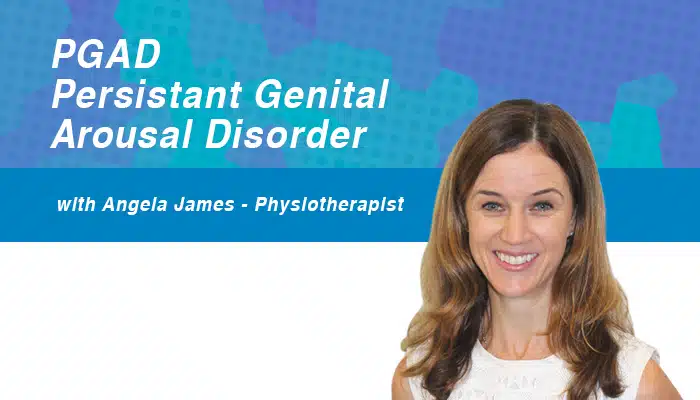Definition & Background
Persistent Genital Arousal Disorder (PGAD) is a condition that sits under the umbrella term of female pelvic pain, which we know affects up to 1 in 5 women.
PGAD is persistent, continuous and unwanted genital arousal unrelated to sexual desire. It is not relieved with orgasm and causes significant distress.
Like many female pelvic pain conditions, PGAD has not been well researched. In fact, PGAD wasn’t recognised as a medical condition until 2001 and it is thought many women didn’t report their symptoms due to embarrassment. This is unfortunate and certainly needs to change, as research-based knowledge underpins positive patient outcomes.
Therefore while there isn’t extensive data on the extent of PGAD suffering, it is evident that this condition has a huge impact on one’s quality of life.
Symptoms of PGAD
Patients suffering with PGAD report their symptoms to be distressing, intrusive, unwanted and sometimes painful.
The following symptoms are often reported by patients suffering with PGAD:
- Sensations of genital arousal persist for many hours or days without dissipating
- Sensations may be triggered by sexual activity, but also by seemingly nonsexual stimuli or by no apparent stimulus at all
- Genital arousal is not readily relieved by one or many orgasms and in fact, for some women, spontaneous and intense orgasms may occur that seem different from the orgasms experienced with the deliberate build-up of sexual excitement
PGAD FAQ
Are there any other names by which which this condition is known?
PGAS persistent genital arousal symptoms
Is there any comparable male condition?
Priapism – long lasting painful erections that are not related to sexual desire.
Is there any specific female demographic that is more / less likely to have this condition?
No.
LISTEN: Angela James and Hannah Reilly discuss Persistent Genital Arousal Disorder in this recording from Triple J’s The Hookup.
What Does PGAD Feel Like?
Think about the sensation of constantly being on edge of sneezing, but never actually sneezing. Or constantly having a full bladder, but no relief with going to the toilet. PGAD is like that, but with a sensation of being on the edge of an orgasm which is not related to sexual desire. It is an extremely distressing condition and patients suffering with it have terrible trouble with focusing on anything else. PGAD has an enormous impact of people’s ability to cope and function with normal activities.
What Causes PGAD?
PGAD is thought to be a problem with the sensory nerves, blood flow or overactive pelvic floor muscles. We have clinically that the superficial pelvic floor muscles, especially the ischiocavernosus and a deep hip muscle, obturator internus, to be the main contributors to PGAD and clitoral pain (or clitoral priapism). It may also be associated with pudendal nerve (PN) problems, as patients can report clitoral pain or irritation as one of their symptoms associated with PN. It has also been linked to psychological issues such as obsessive compulsive type thinking. PGAD has also been linked to Tarlov cysts found in the sacral nerve root, or neurological conditions such as Parkinson’s disease or Epilepsy.
But the answer is that not enough is known about the condition and every women is unique.
How Can Pelvic Physiotherapy Help?
Firstly, our team of specialised pelvic physiotherapists will listen to your story and ask you questions about your symptoms, bladder, bowel and sexual health. We will also ask you about your general health, including medical and surgical history, stress/anxiety levels and any other questions that may be relevant. This is to help us understand your symptoms and its impact on your life. Having a complete story will help us manage you holistically, as lifestyle factors influence your symptoms.
We will then perform an assessment of your pelvis, look at external features such as pelvic/hip alignment, flexibility, strength and specific neural tests. If appropriate we will perform an internal assessment (vaginal) to assess the pelvic floor muscles and the pelvic nerves. If you are uncomfortable with the notion of a pelvic floor examination, we can also assess this through an external ultrasound assessment.
From here, we are able to advise you on what musculoskeletal or neurological issues are contributing to your PGAD symptoms, and formulate a personalised management plan to reduce symptoms and improve the quality of your life.
What is the Treatment for PGAD?
Although research has not resulted in a ‘gold standard’ approach to managing PGAD, we have found the following treatments really helpful for patients suffering with PGAD:
- Education: it is crucial to understand PGAD and what is contributing to your symptoms. Knowing more reduces the stress, anxiety and concern you have over your symptoms and starts to move you into positive action to manage PGAD.
- Manual therapy: to relieve overactivity or spasm in the internal or external pelvic floor muscles.
- Home exercises: to give you targeted tools to manage and improve your symptoms at home. This may include strategies to relieve internal pelvic tension, stretch and release external pelvic muscle tension and mindfulness or meditation to calm down your nervous system.
- Also: Avoiding tight clothing or sitting on vibrating platforms or bumpy car trips. These things may further trigger PGAD symptoms
There may be a need to use medications to assist your healing and recovery, but we will discuss this on an individual basis.
Further Reading & Media
Persistant Genital Arousal Disorder – pelvicpain.org.au

Angela James
This article was brought to you by Angela James. Angela is the Principal Physiotherapist at Sydney Pelvic Clinic. Learn more about Angela and our team here.
Contact Our Team
Contact us: 02 9387 4444 | reception@sydneypelvicclinic.com.au

